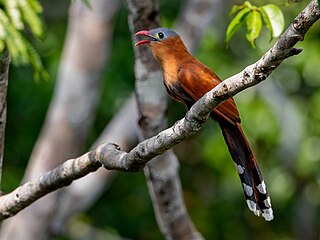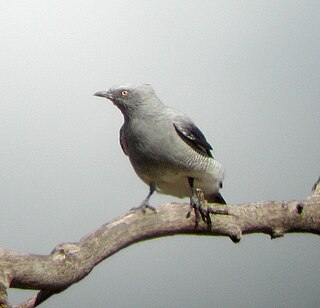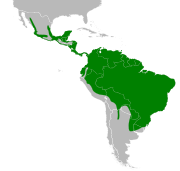
Cuckoos are birds in the Cuculidae family, the sole taxon in the order Cuculiformes. The cuckoo family includes the common or European cuckoo, roadrunners, koels, malkohas, couas, coucals, and anis. The coucals and anis are sometimes separated as distinct families, the Centropodidae and Crotophagidae, respectively. The cuckoo order Cuculiformes is one of three that make up the Otidimorphae, the other two being the turacos and the bustards. The family Cuculidae contains 150 species, which are divided into 33 genera.

The cuckoo, common cuckoo, European cuckoo or Eurasian cuckoo is a member of the cuckoo order of birds, Cuculiformes, which includes the roadrunners, the anis and the coucals.

The parrotbills are a family, Paradoxornithidae, of passerine birds that are primarily native to East, Southeast and South Asia, with a single species in western North America, though feral populations exist elsewhere. They are generally small birds that inhabit reedbeds, forests and similar habitats. The traditional parrotbills feed mainly on seeds, e.g. of grasses, to which their robust bill, as the name implies, is well-adapted. Members of the family are usually non-migratory.

The indigobirds and whydahs, together with the cuckoo-finch, make up the family Viduidae; they are small passerine birds native to Africa.

The black-billed cuckoo is a New World species in the Cuculidae (cuckoo) family. The scientific name is from Ancient Greek. The genus name, kokkuzo, means to call like a common cuckoo, and erythropthalmus is from eruthros, "red" and ophthalmos, "eye".

Brood parasitism is a subclass of parasitism and phenomenon and behavioural pattern of animals that rely on others to raise their young. The strategy appears among birds, insects and fish. The brood parasite manipulates a host, either of the same or of another species, to raise its young as if it were its own, usually using egg mimicry, with eggs that resemble the host's. The strategy involves a form of aggressive mimicry called Kirbyan mimicry.

The white-shouldered tanager is a medium-sized passerine bird. This tanager is a resident breeder from Honduras to Panama, South America south to Ecuador and southern Brazil, and on Trinidad.

The little cuckoo is a species of bird in the cuckoo family (Cuculidae) from South America and Panama. It was formerly placed in the genus Piaya, but was moved to the reinstated genus Coccycua following the discovery that its closest living relatives are a couple species traditionally placed in Coccyzus or Micrococcyx, rather than the other members of Piaya.

The striped cuckoo is a near-passerine bird, the only member of the genus Tapera. This resident cuckoo is found from Mexico and Trinidad south to Bolivia and Argentina and Colombia.

The squirrel cuckoo is a large and active species of cuckoo found in wooded habitats from northwestern Mexico to northern Argentina and Uruguay, and on Trinidad. Some authorities have split off the western Mexican form as the Mexican squirrel-cuckoo.

Cuculus is a genus of cuckoos which has representatives in most of the Old World, although the greatest diversity is in tropical southern and southeastern Asia.

Coccyzus is a genus of cuckoos which occur in the Americas. The genus name is from Ancient Greek kokkuzo, which means to call like a common cuckoo. The genus includes the lizard cuckoos that were formerly included in the genus Saurothera.

The mistletoebird, also known as the mistletoe flowerpecker, is a species of flowerpecker native to most of Australia and also to the eastern Maluku Islands of Indonesia in the Arafura Sea between Australia and New Guinea. The mistletoebird eats mainly the berries of the parasitic mistletoe and is a vector for the spread of the mistletoe's seeds through its digestive system.

The black-bellied cuckoo or black-bellied squirrel cuckoo is a bird of the family Cuculidae found in the Amazon region. Even though this species has a wide distribution, little is known about its ecology and natural history. The word melanogaster means "black belly"; it has Greek roots, melas meaning "black" and gaster meaning "belly".

The cuckoo-finch, also known as the parasitic weaver or cuckoo weaver, is a small passerine bird now placed in the family Viduidae with the indigobirds and whydahs. It occurs in grassland in Africa south of the Sahara. The male is mainly yellow and green while the female is buff with dark streaks. They lay their eggs in the nests of other birds.

The ground cuckoo-shrike is an uncommon bird species endemic to Australia, occurring mainly in open woodland and arid grasslands throughout inland Australia, but also occasionally in areas on the east coast.

Bird eggs are laid by the females and range in quantity from one to up to seventeen. Clutch size may vary latitudinally within a species. Some birds lay eggs even when the eggs have not been fertilized; it is not uncommon for pet owners to find their lone bird nesting on a clutch of infertile eggs, which are sometimes called wind-eggs.






















